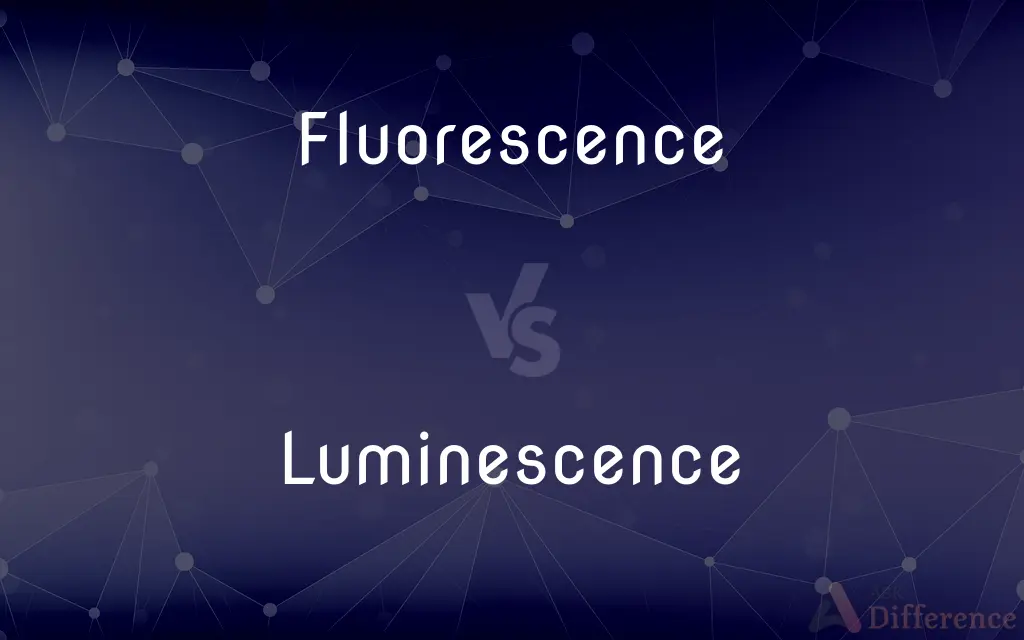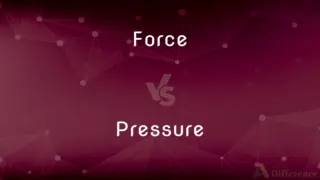Fluorescence vs. Luminescence — What's the Difference?
By Tayyaba Rehman & Urooj Arif — Updated on March 13, 2024
Fluorescence is a type of luminescence where materials emit light immediately upon absorbing light, whereas luminescence encompasses all forms of light emission not caused by heat.

Difference Between Fluorescence and Luminescence
Table of Contents
ADVERTISEMENT
Key Differences
Fluorescence is a phenomenon where certain substances absorb light at one wavelength and quickly re-emit it at a longer wavelength, often seen in minerals, dyes, and biological markers. On the other hand, luminescence covers a broader range of light-emitting processes, including fluorescence, phosphorescence, and bioluminescence, regardless of the light source.
Fluorescent materials have a characteristic quick emission of light after absorbing photons, which typically ceases almost immediately when the light source is removed. In contrast, luminescence can involve processes like phosphorescence, where emitted light continues for a longer period after the excitation source has been removed.
The applications of fluorescence include fluorescence microscopy, fluorescent labeling, and UV-visible markers, which utilize its quick response to light for imaging and identification purposes. Luminescence, however, is used in a wider variety of applications, such as glow-in-the-dark products, emergency lighting, and bio-assays, benefiting from both quick and prolonged light emission techniques.
Fluorescence requires a specific range of wavelengths for excitation and emits light at a higher wavelength, which is a critical property for fluorescent tagging in research and diagnostics. Luminescence does not specify the method of excitation, allowing for chemical, electrical, or physical mechanisms to induce light emission, offering versatility in application.
While fluorescence is highly dependent on the structure of the molecule, with the phenomenon ceasing if the molecular structure is altered, luminescence includes mechanisms like chemiluminescence, where light is produced through chemical reactions, indicating a broader range of emitting conditions.
ADVERTISEMENT
Comparison Chart
Definition
Emission of light by a substance that has absorbed light or other electromagnetic radiation
Emission of light by a substance not caused by heat
Duration of Light Emission
Immediate and ceases almost instantly when the light source is removed
Can be immediate or prolonged, depending on the type
Excitation Source
Light
Light, chemical reactions, electrical energy, etc.
Applications
Fluorescence microscopy, fluorescent tagging, and UV-visible markers
Glow-in-the-dark materials, emergency lighting, bio-assays, etc.
Dependency on Molecular Structure
High, with specific excitation and emission wavelengths
Varies, not always dependent on molecular structure
Compare with Definitions
Fluorescence
The rapid emission of light by a substance after absorbing light.
The fluorescence of the solution became visible under UV light.
Luminescence
Light emission not caused by heat, encompassing various phenomena.
Luminescence is observed in fireflies through a biochemical reaction.
Fluorescence
Inherent in certain dyes and proteins.
Green fluorescent protein is used as a biological marker.
Luminescence
Found in biological organisms (bioluminescence).
Bioluminescence gives the deep-sea fish its glowing appearance.
Fluorescence
Dependent on the substance's ability to absorb and re-emit light quickly.
Certain minerals exhibit strong fluorescence when exposed to ultraviolet light.
Luminescence
Persistent in some substances after removal of the light source (phosphorescence).
The phosphorescence of the material made it glow in the dark.
Fluorescence
Characterized by a shift to a longer wavelength in emitted light.
The fluorescent dye emitted a green light after being excited by blue light.
Luminescence
Can be observed in chemical reactions (chemiluminescence).
The chemiluminescence of the reaction produced a blue glow.
Fluorescence
Utilized in imaging techniques for enhanced visibility.
Fluorescence microscopy allows for detailed cellular observations.
Luminescence
Includes light emission via electrical energy (electroluminescence).
LED lights work on the principle of electroluminescence.
Fluorescence
Fluorescence is the emission of light by a substance that has absorbed light or other electromagnetic radiation. It is a form of luminescence.
Luminescence
Luminescence is spontaneous emission of light by a substance not resulting from heat; or "cold light". It is thus a form of cold-body radiation.
Fluorescence
The emission of electromagnetic radiation, especially of visible light, stimulated in a substance by the absorption of incident radiation and persisting only as long as the stimulating radiation is continued.
Luminescence
The emission of light that does not derive energy from the temperature of the emitting body, as in phosphorescence, fluorescence, and bioluminescence. Luminescence is caused by chemical, biochemical, or crystallographic changes, the motions of subatomic particles, or radiation-induced excitation of an atomic system.
Fluorescence
The property of emitting such radiation.
Luminescence
The light so emitted.
Fluorescence
The radiation so emitted.
Luminescence
(physics) Any emission of light that cannot be attributed merely to the temperature of the emitting body.
Fluorescence
(physics) The emission of light (or other electromagnetic radiation) by a material when stimulated by the absorption of radiation or of a subatomic particle.
Luminescence
Any emission of light not ascribable directly to incandescence, and therefore occurring at low temperatures, as in phosphorescence and fluorescence or other luminous radiation resulting from vital processes, chemical action, friction, solution, or the influence of light or of ultraviolet or cathode rays, etc.
Fluorescence
The light so emitted.
Luminescence
The faculty or power of producing light by biological processes, as in the firefly and glowworm. Also called bioluminescence.
Fluorescence
A luminescence emitted by certain substances due to the absorption of radiation at one wavelength, and the almost instantaneous re-emission of radiation at another, usually longer wavelength. The re-radiation stops almost as soon as the incident radiation is halted, thus distinguishing this phenomenon from phosphorescence, in which re-radiation of light may continue for some time after the incident radiation is halted.
Luminescence
Light not due to incandescence; occurs at low temperatures
Fluorescence
Light emitted during absorption of radiation of some other (invisible) wavelength
Luminescence
Light from nonthermal sources
Common Curiosities
Is all fluorescence visible to the human eye?
Not all; some fluorescence occurs in the UV or infrared spectrum, invisible to the human eye.
What distinguishes luminescence from fluorescence?
Luminescence is a broader category that includes all light emissions not caused by heat, while fluorescence is a specific type of luminescence that stops when the light source is removed.
Can luminescence occur without light?
Yes, through chemical reactions, physical pressure, or electrical energy, among other causes.
What is bioluminescence?
A type of luminescence produced by living organisms, often seen in deep-sea creatures.
How is electroluminescence used in technology?
In the production of light-emitting diodes (LEDs) and screens for electronic devices.
What causes fluorescence?
Fluorescence is caused by the absorption of light at one wavelength and its rapid re-emission at a longer wavelength.
How is fluorescence used in security?
In watermarks, banknotes, and documents to prevent counterfeiting.
Are there practical uses for fluorescence?
Yes, in medical diagnostics, research, and fluorescent lighting, among other applications.
What is phosphorescence?
A type of luminescence where the emitted light continues for a time after the excitation source is removed, unlike the immediate cessation in fluorescence.
How do fluorescent dyes work?
They absorb light at specific wavelengths and re-emit it at a longer wavelength, making them visible as bright colors under certain lights.
Why do some substances exhibit fluorescence under UV light?
They have the ability to absorb UV light and re-emit it at a visible wavelength.
What is chemiluminescence?
Luminescence resulting from a chemical reaction, often used in scientific assays.
What role does fluorescence play in nature?
It can be used for signaling, camouflage, or attracting prey among various organisms.
Can fluorescence be used to track environmental changes?
Yes, through the detection of fluorescent markers in various studies, including pollution tracking and ecosystem monitoring.
Can luminescence be harmful?
Generally, it is not harmful, but the substances used to produce it or the processes to generate it can be, depending on the context.
Share Your Discovery

Previous Comparison
Configuration vs. Conformation
Next Comparison
Force vs. PressureAuthor Spotlight
Written by
Tayyaba RehmanTayyaba Rehman is a distinguished writer, currently serving as a primary contributor to askdifference.com. As a researcher in semantics and etymology, Tayyaba's passion for the complexity of languages and their distinctions has found a perfect home on the platform. Tayyaba delves into the intricacies of language, distinguishing between commonly confused words and phrases, thereby providing clarity for readers worldwide.
Co-written by
Urooj ArifUrooj is a skilled content writer at Ask Difference, known for her exceptional ability to simplify complex topics into engaging and informative content. With a passion for research and a flair for clear, concise writing, she consistently delivers articles that resonate with our diverse audience.














































